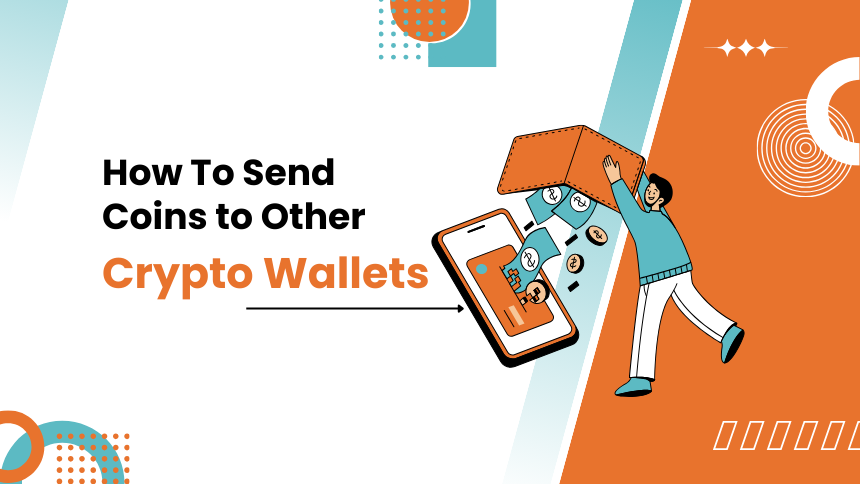Introduction
In the vast world of cryptocurrencies, managing your digital assets often involves transferring funds between different or other crypto wallets. Whether you’re diversifying your portfolio, making payments, or simply storing your coins in different wallets for added security, knowing how to send coins to other crypto wallets is an essential skill for any crypto enthusiast. In this article, we’ll provide a comprehensive guide on how to send coins to other crypto wallets in India, covering the steps, considerations, and best practices to ensure a smooth and secure transaction experience.
Understanding Crypto Wallets:
Before delving into the process of sending coins to other crypto wallets, it’s crucial to understand the concept of crypto wallets and the different types available:
- Software Wallets: Software wallets are digital applications or programs that allow users to store, send, and receive cryptocurrencies. These wallets can be installed on computers, smartphones, or tablets, providing convenient access to your digital assets. Examples include Exodus, Trust Wallet, and Atomic Wallet.
- Hardware Wallets: Hardware wallets are physical devices designed to store cryptocurrencies offline, providing an extra layer of security against online threats such as hacking and malware. These wallets are considered one of the safest storage options for long-term asset protection. Popular hardware wallets include Ledger Nano S, Trezor, and KeepKey.
- Web Wallets: Web wallets, also known as online wallets, are hosted on remote servers and accessed through web browsers. While convenient for accessing funds from any internet-connected device, web wallets are considered less secure than software and hardware wallets due to the risk of hacking and server vulnerabilities. Examples include MyEtherWallet (MEW) and MetaMask.
- Paper Wallets: Paper wallets are physical documents or printouts that contain your cryptocurrency’s public and private keys. These wallets provide an offline storage solution for securely storing large amounts of cryptocurrency for extended periods of time. However, they require careful handling and protection against physical damage and loss.

Step-by-Step Guide to Sending Coins to Other Crypto Wallets:
1. Choose the Right Wallet:
Select a crypto wallet that meets your needs in terms of security, convenience, and supported cryptocurrencies. Ensure that the recipient’s wallet supports the type of cryptocurrency you intend to send.
2. Access Your Wallet:
Log in to your crypto wallet using your credentials, or unlock your hardware wallet using the provided PIN or passphrase. Navigate to the “Send” or “Send/Receive” section of the wallet interface.
3. Enter Recipient’s Wallet Address:
Obtain the recipient’s wallet address, which is a unique alphanumeric string used to identify their crypto wallet. Double-check the address to ensure accuracy, as transactions sent to the wrong address cannot be reversed.
4. Specify Amount and Currency:
Enter the amount of cryptocurrency you wish to send and select the currency type (e.g., BTC for Bitcoin, ETH for Ethereum). Some wallets also allow you to specify the transaction fee or choose from preset fee options.
5. Review Transaction Details:
Take a moment to review the transaction details, including the recipient’s wallet address, the amount of cryptocurrency being sent, and any associated transaction fees. Verify that all the information is correct before proceeding.
6. Confirm Transaction:
Once you’re satisfied with the transaction details, confirm the transaction to initiate the sending process. Depending on the wallet interface, you may need to enter your password, PIN, or confirm the transaction using a hardware wallet.
7. Monitor Transaction Status:
After confirming the transaction, monitor the transaction status on the blockchain explorer or within your wallet interface. Transactions typically take some time to be confirmed and added to the blockchain, depending on network congestion and transaction fees.
Considerations and Best Practices:
- Security: Keep your crypto wallet and private keys secure by using strong passwords, enabling two-factor authentication (2FA), and storing your hardware wallet in a safe place.
- Double-Check Addresses: Always double-check the recipient’s wallet address before sending any cryptocurrency to avoid sending funds to the wrong address.
- Transaction Fees: Consider the network congestion and transaction fees associated with sending coins to other crypto wallets, especially during periods of high demand.
- Backup Your Wallet: Regularly backup your crypto wallet to ensure that you can recover your funds in case of loss or theft. Follow the backup instructions provided by your wallet provider.
Conclusion:
Sending coins to other crypto wallets is a fundamental aspect of managing your cryptocurrency holdings effectively. By following the steps outlined in this guide and considering important factors such as wallet security, recipient addresses, transaction fees, and backup procedures, you can ensure a smooth and secure transaction experience. Whether you’re transferring funds between your own wallets or sending coins to friends, family, or trading platforms, understanding how to send coins to other crypto wallets empowers you to take full control of your digital assets and participate confidently in the world of cryptocurrencies.
